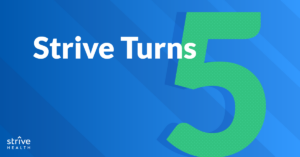Managing the ESRD Population: ACOs and the Need for Specialized Kidney Care Programs
Author : Renee George, Senior Vice President of Market OperationsThe most recent report from the Medicare Shared Savings Program (MSSP) shows 2019 to be the largest-ever year of savings, with 541 participating Accountable Care Organizations (ACOs) creating $1.19 billion.
Despite this, one subset of patients continues to drive higher costs for this Centers for Medicare and Medicaid Services (CMS) value-based payment program. Strive’s actuarial team analyzed the ACOs listed in the 2019 MSSP data to understand ESRD performance. We estimated an updated ESRD benchmark for each ACO based on regional trend and risk scores using publicly available data, and compared 2019 performance year to that updated benchmark. We found that 38% of participating ACOs lost money on their ESRD population. Had these ACOs managed their ESRD patients more effectively, some would have generated significantly higher savings, and some would have even moved from the “loss” category into savings.
Poor management of ESRD should come as no surprise, given the ongoing, complex, and costly care required by ESRD patients. Without specialized kidney care programs that focus on ESRD management, caring for this high-cost patient population will continue to be a cost burden for even the most financially successful ACOs.
The Cost to Care for ESRD
Before joining Strive Health, I worked for a leading Ohio health system entering the value-based care environment. There, we launched a provider-led health plan, an ACO, and a clinically integrated network. This enabled our system to take on risk contracts with government and commercial payers.
As we looked to reduce costs, our Next Generation ACO analyzed all conditions by disease state to determine the highest spend per beneficiary. Chronic kidney disease (CKD) and ESRD were among the highest expenditures. On average, 4-5% of our spend on a 22,000-member population was spent managing ESRD.
Because the kidney population was small, we prioritized it for intervention using a combination of focused care management, primary care physician (PCP) engagement and an emergency department (ED) diversion program to reduce unnecessary hospital admissions from the ED. This strategy was an important factor in propelling the organization from losses into shared savings.
CMS data shows the average per-patient, per-year spend on an ESRD patient is $84,000. Though ESRD patients account for only 0.7% of MSSP ACO populations, they make up 7% of spending. In total — with 70,000 of these patients under their care — ACOs spend almost $6 billion annually on members with ESRD.
Where Savings Remain Untapped
While care for ESRD is naturally costly, unnecessary spending is also common. On average, ACOs that lost money on ESRD patients spent an estimated $4000 PPPY over their ESRD benchmark. To calculate your estimated ESRD spend, use our ESRD Spend Calculator.
This excessive spending comes from a number of causes unique to ESRD, including avoidable hospitalizations, which can be symptomatic of an uncoordinated patient journey and a fragmented care delivery system. ESRD patients average 1.7 inpatient admissions yearly, often resulting from vascular access complications, missed dialysis appointments, or crash dialysis starts.
Partnering to Manage the ESRD Population
Given the level of complexity in ESRD, impacting quality and cost of care requires a specialized approach that directly addresses the drivers of high-cost events. ACOs don’t have to solve this alone. Partnering with an organization that takes a value-based approach to kidney disease could be a high-impact solution.
What to Look for in a Value-Based Kidney Care Partner
- Access to data/analytics. With the right information in hand, ACOs can identify patients at risk for high-cost events in real time. A good technology partner can deliver actionable insights like risk scores, ESRD crash predictions, and even artificial intelligence (AI) algorithms to identify those with undiagnosed disease.
At Strive Health, we integrate claims, clinical, and lab data to develop a holistic understanding of a patient’s health picture. This allows us to use our predictive analytics to determine which patients are at risk for future high-cost events. We then embed these insights into our purpose-built EMR and care management platform, allowing our clinicians to intervene with the right patients at the right time.
- Upstream management. One of the largest value opportunities related to ESRD management is to identify and manage pre-ESRD patients to prevent the progression of kidney disease and avoid dialysis altogether. Even if patients do progress to ESRD, “upstream” management can help them be more prepared and experience better outcomes later in their kidney disease journey. Traditionally, this has been a gap in kidney care. Collaborating directly with PCPs to identify their pre-ESRD patients and ensure that they are receiving the appropriate level of kidney-specific care is a critical step toward improving the patient journey.
- Provider alignment. People with kidney disease often experience multiple co-morbidities and many face socioeconomic factors that impact their health. As a result, these patients see multiple specialists, but little coordination exists across providers. Not only does this result in poor patient experience, it also leads to missed opportunities to provide proactive, preventive care.
Better alignment by all providers involved in the care for these patients — including nephrologists, PCPs, and dialysis clinics — improves continuity of care and adherence to a care plan. Strive Health works with health systems and medical groups to develop integrated clinical workflows that ensure providers are coordinated around the patient’s care plan. - Renal-specialized care. Both patients and providers can benefit from an extra layer of specialized support for ESRD. A partner with renal care expertise can focus on renal-specific complications that are likely to drive adverse events. These may include kidney function, diet, access placements, medication reconciliation, and wound care. PCPs within the ACO are then freed to focus more time and energy on the non-ESRD population, spend more time with patients, close more care gaps, and improve quality of care for their broader population.
Our kidney heroes are nurse practitioners and care managers that are specially trained in kidney care delivery. They work directly with nephrologists and PCPs to coordinate care, ensuring that a patient’s care plan is executed effectively. Delivering these specialized resources enables us to provide a turn-key solution to health systems that improves patient outcomes, while also creating capacity for health system physicians and care managers to focus on their broader populations.
Strive Health Can Help You Navigate CKD and ESRD Care
At Strive Health, we work with health systems to build infrastructure to succeed in value-based kidney care. We can help ACOs seeking to transform the way their patient population experiences kidney disease. Read more about our care model.
Strive put together a calculator that allows you to determine estimate send on your ACO’s ESRD population. To calculate your estimated spend, use our ESRD Spend Calculator.
To discuss partnering to manage a kidney disease population, email us at info@strivehealth.com or complete our contact form.
Note: Analysis included 413 of the 541 ACOs. Some were excluded if the number of assigned beneficiaries by county were not listed, as we were unable to calculate the regional trend.








